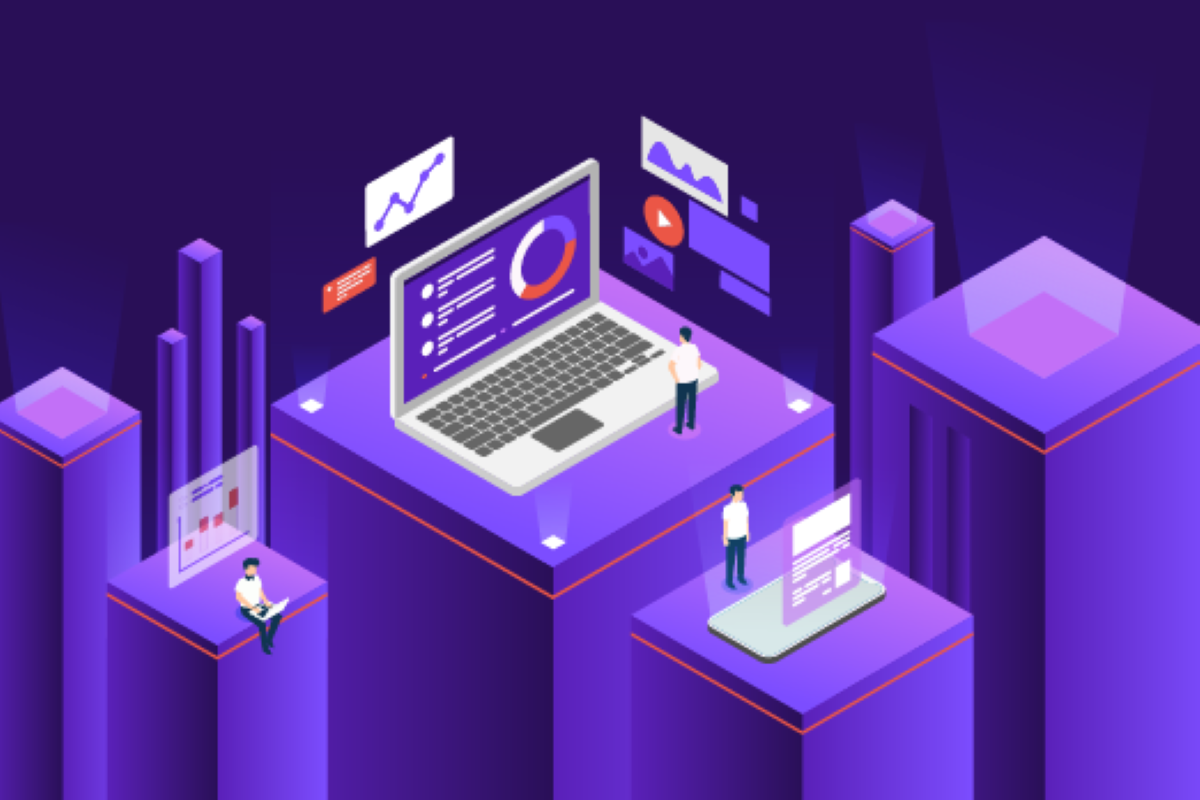Composable technology: Build flexible digital solutions without limits

Discover how composable technology adoption is shaping the future of digital experiences. Experience unparalleled freedom of creativity, increased speed and provide teams with omnichannel content, while allowing them to innovate. It’s time to build smarter, faster and better using the composable tech.
Highlights
You’ll learn why composable technology is the future of digital experience:
- Flexibility and scalability: You can quickly adapt to tech and market demands
- Speed and business agility: Deploy features, updates and content faster across channels
- Innovative edge: Frees IT teams to focus on new features and technology innovations
- Personalization: Real-time data helps you personalize user experiences
Let’s face it, digital experiences are not only changing but evolving at a breakneck pace. What about your tech stack? It has to keep up and not drag you down. And that’s why you need composable DXPs. These DXPs are like the LEGO or building blocks: flexible, easy to work with and adaptable to what you require next. But what exactly does composable mean for you and your business? And more importantly, should you make the switch?
In this post, we explore:
Why experts say modular architecture is the way of the future
- Potential benefits of a composable digital experience platform (DXP)
How to get started and why being “fully composable” matters
What is a composable DXP?
A composable Digital Experience Platform (DXP) is a flexible, modular system used by companies to provide smoother digital experiences. Composable DXPs bring together the best-of-breed tools like personalization, analytics and content management using APIs. They do not lock you in a one, stiff all-in-one suite. Instead, they help you choose what you require and connect different components to create a personalized digital ecosystem. The composable approach is less rigid, simpler to upgrade and allows your team to produce a never-before experience using all digital channels.
A media publisher uses a composable DXP for digital publishing, combining a headless CMS, video delivery platform and dynamic ad personalization service. This setup delivers targeted, high-quality content on web, mobile and smart TVs without overhauling their entire system.
Start your free trial with Contentstack today. Transform your brand's digital presence with Contentstack's open MACH architecture and industry-leading technology. Witness a significant reduction in publishing and development time, and elevate your content management. Start your free trial now.
Why a composable DXP is the way of the future
As businesses transition through digital transformation and digital commerce evolves, customers expect to interact with your digital products and services and don't settle for anything less than a seamless and personalized experience. Monolithic systems, which require IT teams to code every change and update, can’t rapidly respond to customer preferences and publish fresh omnichannel content.
According to Gartner Research, “By 2026, at least 70% of organizations will be mandated to acquire composable DXP technology, as opposed to monolithic DXP suites, compared to 50% in 2023.”
Benefits of a composable DXP
Flexibility, scalability and faster development
Composable architecture allows organizations to choose and integrate a unique mix of best-in-breed tools and microservices and to adjust this mix as business needs evolve. The modular components support the seamless integration of these independent best-in-breed solutions. You can add, remove or recombine components without downtime. The ability to deploy services independently enables organizations to scale faster and more efficiently as needed.
Speed and agility
Since microservices are scalable and modular, they operate as independent components connected via application programming interfaces (APIs). You can update these components as needed, in phases, without affecting other tools, services or channels. As a result, companies become more agile. This enhances the experience strategy, allowing them to respond more quickly to changing customer expectations and deliver up-to-date content experiences.
Ease of use
Your marketing team can change the look and feel of your website or campaign without having to code or wait for IT tickets, thanks to the composable technology. A single dashboard will allow you to control, edit and launch content and govern workflows on various sites. Because of the built-in user permissions, you provide access to the right people, allowing them to review and approve the content before publishing.
Rapid innovation
Traditional, monolithic platforms require hundreds of hours from your tech team to make updates or add new features. However, with composable solutions, it’s significantly easier. You have the freedom to add additional apps or integrations as needed, without interfering with other software components. Now your IT staff can spend time trying to innovate and create more impressive customer experiences instead of being caught up in maintenance and solving one request after another.
Increased ROI
A composable software reduces both development and publishing time, resulting in reduced costs and increased profit.
Real-time feedback
To get a real-time 360-degree view of your customers, you need website and social media analytics, customer relationship management and other sources of data. You can collect the data through different tools and microservices deployed in a composable architecture. This provides personalization, offering customers a real-time and relevant experience, enhancing your technology architecture.

Omnichannel content deployment
When you have a composable DXP with a headless CMS, your content is not limited to one channel and one format. You design it once and publish it on your websites, mobile apps, social sites and digital kiosks, all from a single location. This encourages your marketing team to rapidly personalize and push campaigns to all touchpoints without requiring developer intervention or managing diverse systems.
Getting started on the journey to composable architecture
If your current digital experience solution is holding you back from experiencing the benefits above, it may be time to switch to a composable DXP. While there are many small business processes, stakeholder buy-in is essential. Here is a three-point summary of how to approach it.
- Audit current platform: List everything that is not working in your current platform. Consider the parts that are working well to meet your business's needs and whether those needs will change soon. This clarifies which apps, mobile apps and microservices you should include in your future solution and how to approach implementing it.
- Research DXP vendors: Select digital experience platforms that fit your business needs. Always prioritize MACH-compliant, composable DXP platforms, such as Contentstack.
- Adopt a phased approach: Implement composable applications in key areas, such as those where your monolithic platform is slowing you down. This ensures there are no disruptions to your current operations and your team has time to familiarize themselves with the new platform.
Case studies
MongoDB
MongoDB had multiple CMSes to manage their five core websites, which was costly to maintain and led to misalignment of IT and business. Contentstack modernized its technology stack, enabling it to migrate over 250 pages with support in multiple languages.
Subi Babu said. "Coming from an in-house CMS, our background for several years was focused on developing CMS features. Now, we can use the marketplace and get plug-and-play integrations, which is exciting."
Read on to see how MongoDB modernized through a composable business model.
Air France-KLM
Air France-KLM's legacy system was slow and required two weeks to update content. They also used multiple CMSes for their different brands. It was costly and inefficient. Contentstack's composable DXP allowed them to align IT and business and streamline operations. The headless CMS offers them a single source of truth to manage content for their entire website.
Ralf Schipper, the Product Owner, had this to say."With Contentstack, we are changing the way we distribute content and paving the way for personalization. We’re defining the solution to master content distribution and optimize content creation and management."
Read more to see how Air France-KLM enhanced its operations with a composable system.
Contentstack: Your partner in scaling digital experiences. Twice named a Leader in Forrester's composable DXP award, Contentstack offers an innovative approach to DXP. Experience our 100% microservices architecture and API coverage that allows instant scalability. Start your free trial today.
Does being ‘fully composable’ really matter?
If you’re wondering if it makes a difference whether a DXP is fully composable or not, it matters a great deal. A DXP built on monolithic architecture will not deliver all the great benefits of a fully composable platform we’ve covered in this blog. It will have many limitations that a fully composable platform won’t have.
In a monolithic architecture, the vendor controls the type of technology that can be used. Your organization rarely has the flexibility to choose and leverage the best available apps and microservices. A fully composable DXP offers the flexibility to select the best solutions and future-proof your tech stack, enabling you to consistently leverage the most up-to-date technology necessary for success. The architecture creates a unique DXP that evolves to continuously align with business needs, without being limited by a vendor.
FAQs
What is a composable digital experience?
A composable digital experience is a digital experience built using a modular, flexible platform where different components can be selected from various vendors and integrated via APIs.
Why use a composable architecture?
Composable architecture is an approach to designing and building applications by combining self-contained, independent and interchangeable modules.
What are the benefits of composable?
It offers many benefits, such as cost-efficiency, agility, faster time to market and better customer experience.
Learn more
The future of digital experience is not one-size-fits-all. It’s flexible, fast and personalized. A composable DXP enables you to build freely and create tailored solutions that meet the needs of your teams and customers, without any technical baggage. Be it scaling up, experimental new tools or speeding up, composable is the future-proof decision to make.
It's no longer a matter of keeping up. It’s about staying ahead, too, on your terms.
So, let’s build something better, together with Contentstack. Talk to us to know more.
Last update: July 24, 2025
About Contentstack
The Contentstack team comprises highly skilled professionals specializing in product marketing, customer acquisition and retention, and digital marketing strategy. With extensive experience holding senior positions at renowned technology companies across Fortune 500, mid-size, and start-up sectors, our team offers impactful solutions based on diverse backgrounds and extensive industry knowledge.
Contentstack is on a mission to deliver the world’s best digital experiences through a fusion of cutting-edge content management, customer data, personalization, and AI technology. Iconic brands, such as AirFrance KLM, ASICS, Burberry, Mattel, Mitsubishi, and Walmart, depend on the platform to rise above the noise in today's crowded digital markets and gain their competitive edge.
In January 2025, Contentstack proudly secured its first-ever position as a Visionary in the 2025 Gartner® Magic Quadrant™ for Digital Experience Platforms (DXP). Further solidifying its prominent standing, Contentstack was recognized as a Leader in the Forrester Research, Inc. March 2025 report, “The Forrester Wave™: Content Management Systems (CMS), Q1 2025.” Contentstack was the only pure headless provider named as a Leader in the report, which evaluated 13 top CMS providers on 19 criteria for current offering and strategy.
Follow Contentstack on LinkedIn.







.svg?format=pjpg&auto=webp)
.svg?format=pjpg&auto=webp)
.png?format=pjpg&auto=webp)






.png?format=pjpg&auto=webp)


